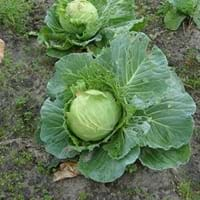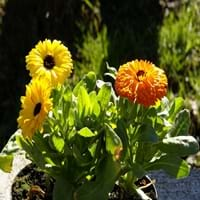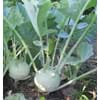Life Span
Annual
Perennial
Type
Vegetable
Flowering Plants
Origin
Europe, Mediterranean, Canary Islands, Northern Africa
Europe, Mediterranean
Types
Not Available
Kablouna Gold, Fiesta Gitana, Art Shades
Habitat
Not Available
gardens, Roadsides, Waste areas, wastelands
USDA Hardiness Zone
Not Available
3-9
Sunset Zone
A1, A2, A3, H1, H2, 1a, 1b, 2a, 2b, 3a, 3b, 4, 5, 6, 7, 8, 9, 10, 11, 12, 13, 14, 15, 16, 17, 18, 19, 20, 21, 22, 23, 24
A2, A3, H1, 1a, 1b, 2a, 2b, 3a, 3b, 4, 5, 6, 7, 8, 9, 10, 11, 12, 13, 14, 15, 16, 17, 18, 19, 20, 21, 22, 23, 24
Habit
Rosette/Stemless
Clump-Forming
Flower Color
Yellow
Yellow, Orange, Bronze, Ivory
Flower Color Modifier
Bicolor
Bicolor
Fruit Color
Brown
Green, Tan
Leaf Color in Spring
Not Available
Green
Leaf Color in Summer
Green, Gray Green, Dark Green
Green
Leaf Color in Fall
Green, Gray Green
Green
Leaf Color in Winter
Green, Gray Green
Light Green
Leaf Shape
Spinach Type
Oblong-lanceolate
Plant Season
Spring, Fall, Winter
Early Autumn, Spring, Summer
Sunlight
Full Sun, Partial Sun
Full Sun, Partial shade, Partial Sun
Type of Soil
Loam, Sand
Well drained
The pH of Soil
Neutral, Alkaline
Acidic, Alkaline, Neutral
Soil Drainage
Well drained
Average
Bloom Time
Spring, Late Spring, Early Summer
Early Winter
Tolerances
Drought
Drought
Where to Plant?
Container, Ground, Pot
Ground, Pot
How to Plant?
Seedlings
Seedlings, Transplanting
Plant Maintenance
Medium
Medium
Watering Requirements
Do Not over Water
Requires regular watering
In Summer
Lots of watering
Lots of watering
In Spring
Moderate
Moderate
In Winter
Average Water
Average Water
Soil pH
Neutral, Alkaline
Acidic, Alkaline, Neutral
Soil Type
Loam, Sand
Moist, Well drained
Soil Drainage Capacity
Well drained
Not Available
Sun Exposure
Full Sun, Partial Sun
Partial shade
Pruning
No need to prune, Remove damaged leaves, Remove dead branches, Remove dead leaves
Cut or pinch the stems, Remove damaged leaves, Remove dead branches, Remove dead leaves
Fertilizers
Nitrate based fertilizers
All-Purpose Liquid Fertilizer
Pests and Diseases
Alternaria Leaf Spot, Anthracnose, Aphids, Beet armyworm, Black rot, Cabbage looper, Cercospora leaf spot, Clubroot, Cutworms, Damping-off, Diamondback moth, Downy mildew, Flea Beetles, Leaf spot, Red blotch, Root knot nematode, Thripes
Red blotch
Plant Tolerance
Drought
Drought
Flower Petal Number
Single
Double, Semi-Double
Foliage Texture
Bold
Medium
Foliage Sheen
Matte
Matte
Attracts
Bugs
Beetles, Butterflies, Flying insects
Allergy
Not Available
Dizziness, Itchiness, Nausea, Skin rash, Swelling
Aesthetic Uses
Not Used For Aesthetic Purpose
Showy Purposes
Beauty Benefits
Not Available
Good for skin and hair, Skin cleanser, Skin Problems, used as a dye
Environmental Uses
soil erosion prevension on hill slopes
Air purification
Medicinal Uses
anti-cancer, Heart problems
Curing mumps and measles, Cuts, Reduces toothache, Surgical wounds, Throat infection, Ulcers
Part of Plant Used
Leaves
Flowers, Leaves, Root
Other Uses
Used as a vegetable
Cosmetics, Sometimes used for making wine, Used as an insecticide, Used as essential oil, Used As Food, Used as Ornamental plant, Used in salads
Used As Indoor Plant
No
Insignificant
Used As Outdoor Plant
Yes
Yes
Garden Design
Container, Edible, Herb / Vegetable
Groundcover, Showy Tree
Botanical Name
BRASSICA oleracea
CALENDULA officinalis
Common Name
Carolina Cabbage Collard Greens, Collard Greens
Pot Marigold
In Hindi
collard साग
Pot Marigold
In German
Blattkohl
Ringelblume
In French
Chou cavalier
pot Marigold
In Spanish
Brassica oleracea viridis
Caléndula
In Greek
λάχανο
καλέντουλα
In Portuguese
greens kollard
pot Marigold
In Polish
kollard zieleni
Pot Marigold
In Latin
vireta kollard
Zinnia Pot
Phylum
Magnoliophyta
Vascular plant
Class
Magnoliopsida
Magnoliopsida
Order
Brassicales
Asterales
Family
Brassicaceae
Asteraceae
Clade
Not Available
Angiosperms, Asterids, Eudicots
Tribe
Brassiceae
Calenduleae
Subfamily
Not Available
Asteroideae
Importance of Collard Greens and Pot Marigold
Want to have the most appropriate plant for your garden? You might want to know the importance of Collard Greens and Pot Marigold. Basically, these two plants vary in many aspects. Compare Collard Greens and Pot Marigold as they differ in many characteristics such as their life, care, benefits, facts, etc. Every gardener must at least have the slightest clue about the plants he wants to plant in his garden. Compare their benefits, which differ in many ways like facts and uses. The medicinal use of Collard Greens is anti-cancer and Heart problems whereas of Pot Marigold is Curing mumps and measles, Cuts, Reduces toothache, Surgical wounds, Throat infection and Ulcers. Collard Greens has beauty benefits as follows: Not Available while Pot Marigold has beauty benefits as follows: Not Available.
Compare Facts of Collard Greens vs Pot Marigold
How to choose the best garden plant for your garden depending upon its facts? Here garden plant comparison will help you to solve this query. Compare the facts of Collard Greens vs Pot Marigold and know which one to choose. As garden plants have benefits and other uses, allergy is also a major drawback of plants for some people. Allergic reactions of Collard Greens are Not Available whereas of Pot Marigold have Dizziness, Itchiness, Nausea, Skin rash and Swelling respectively. Having a fruit bearing plant in your garden can be a plus point of your garden. Collard Greens has no showy fruits and Pot Marigold has no showy fruits. Also Collard Greens is not flowering and Pot Marigold is flowering. You can compare Collard Greens and Pot Marigold facts and facts of other plants too.





